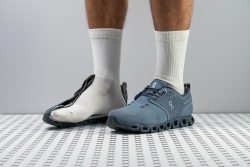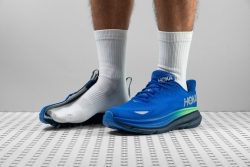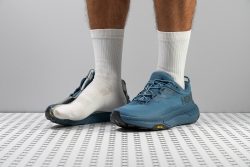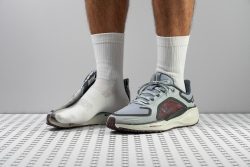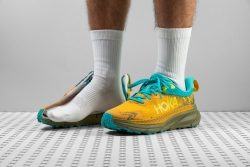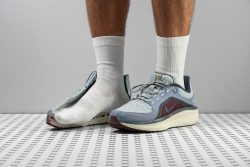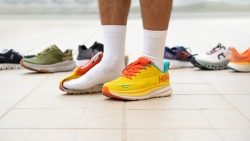6 Best Waterproof Walking Shoes in 2025
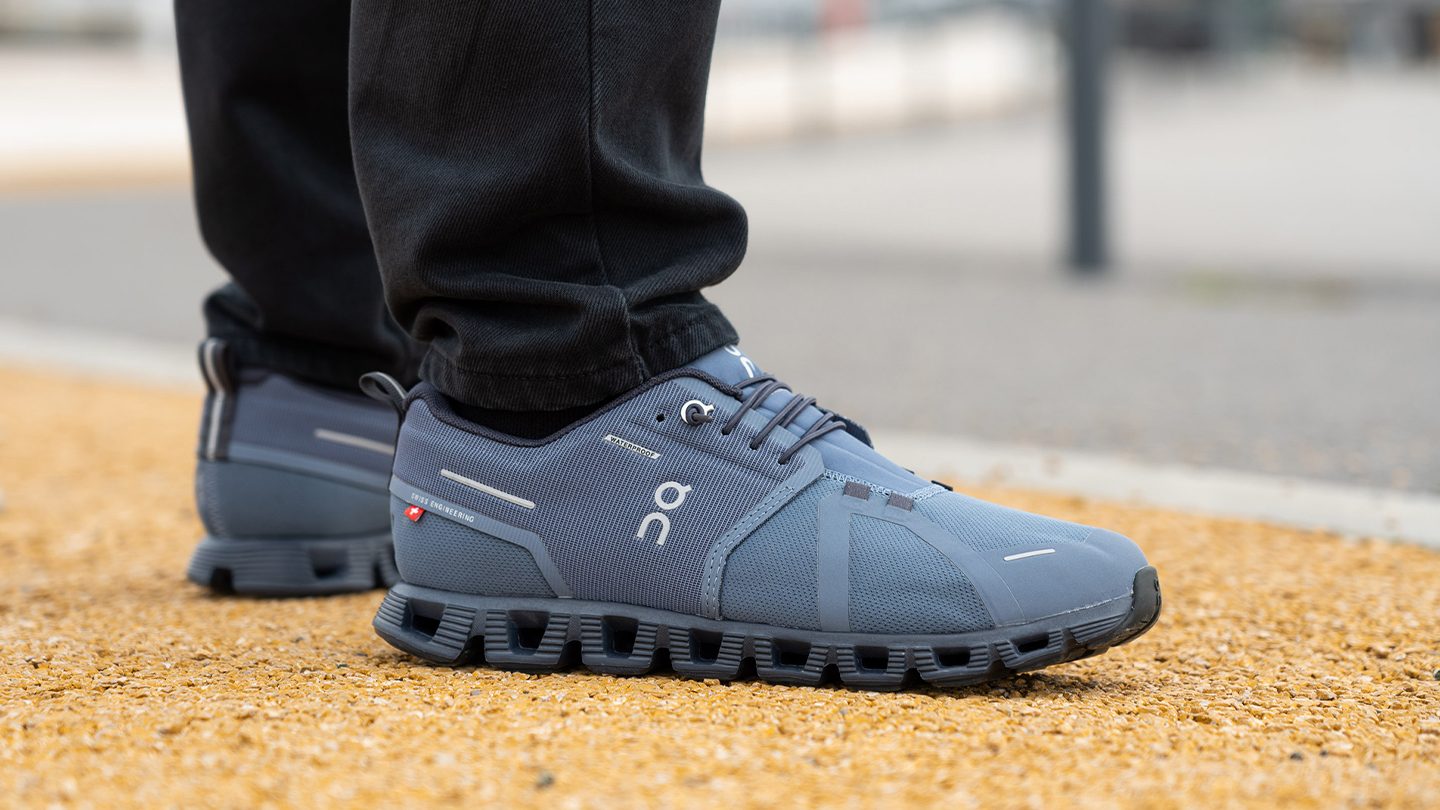
We buy shoes ourselves. We earn commissions when you buy through us, at no extra cost. Why trust us
Stay dry and own the streets or even the trails with our carefully selected waterproof walking shoes.
Yes, there’s no need for you also to invest in a pair of burly boots to get you walking outside in the rain. Walking kicks from several brands are specifically constructed to tackle rainy weather.
For all-day walking comfort and protection against water splashes or rain, we’ve listed the best waterproof walking shoes among all the ones we have tested. We have subjected each pair to rigorous tests to assess their quality and overall value.
How we test waterproof walking shoes
To select our top picks, we test all walking shoes around the city and in our lab. These are the steps involved:
- Buy waterproof walking footwear from different brands for the tests. We spend the money we have to ensure our reviews are not influenced by outside parties. We also have no brand ambassadors on the team!
- Perform wear tests on each model. We then give our final assessments of its fit, comfort, waterproof features, arch support, motion control, weight, stability, durability, and more.
- Cut the shoes into pieces so we can see and assess every little detail of the shoe. Use lab tools and devices to deliver 20+ data points that accurately describe different shoe features.
Best waterproof walking shoes overall
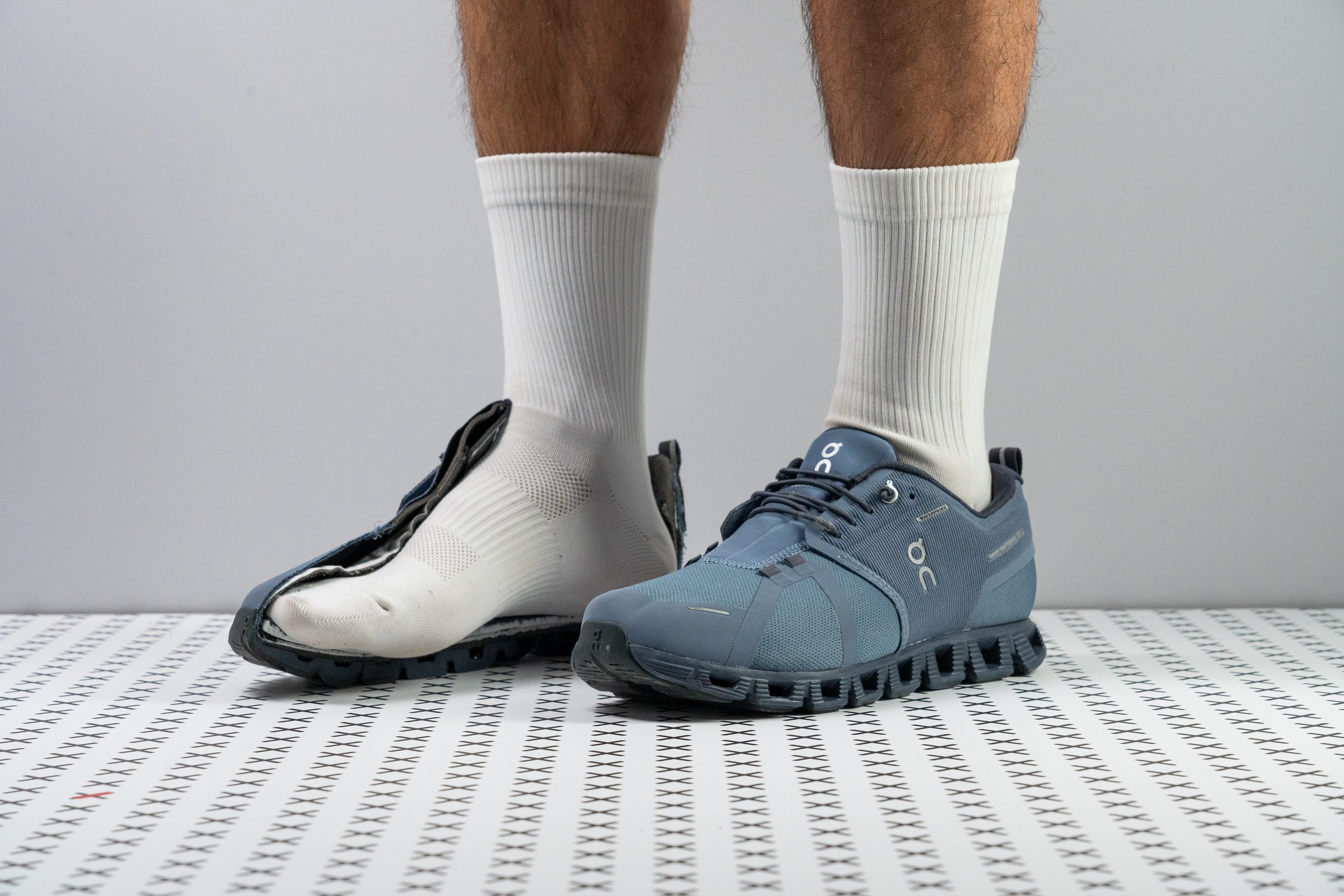









































What makes it the best?
Not your ordinary waterproof walking shoes – this is the On Cloud 5 Waterproof. It’s our top-pick walking shoe because, in rain and snow, it gets our feet out of any wet situation dry as a bone. The best part is it’s waterproof, but it doesn’t spoil the stellar in-shoe feel and the overall walking experience.
We got our smoke machine, microscope, and expertise to work to test the level of waterproofing of this shoe. To see how prohibitive the upper was, we drove smoke inside the shoe and gauged the amount that was emancipated. Seeing that the upper freed a small amount of smoke, we scored the breathability 1/5. To substantiate our findings, we looked over our microscope and discovered that the upper is very closely knitted, making it extremely difficult for fluid to seep through.
We also felt safe wandering over wet grounds because of the stability brought by the shoe. We measured the midsole width in the heel and forefoot at 83.7 mm and 104.6 mm. While these measurements are 4.6% and 4.8% behind the average, we still felt balance and steadiness even in puddles.
Comfort-wise, the midsole is 17.4% harder than average at 30.4 HA, providing us with pleasant springs on our strides. Beware, though, this did get 37.9% harder when we put the shoe inside our freezer for 20 minutes. Unless you don’t mind warming up the shoe first for your snowy adventures, look for another pair.
Pros
- Perfect for all-day wear
- Super light for its kind
- Easy on-and-off
- Amazing in-shoe feel
- Sustainable materials (40%)
- Regular laces are added
- Reflective elements
Cons
- Catches rocks and debris
- Can get smelly
Best lightweight waterproof walking shoes
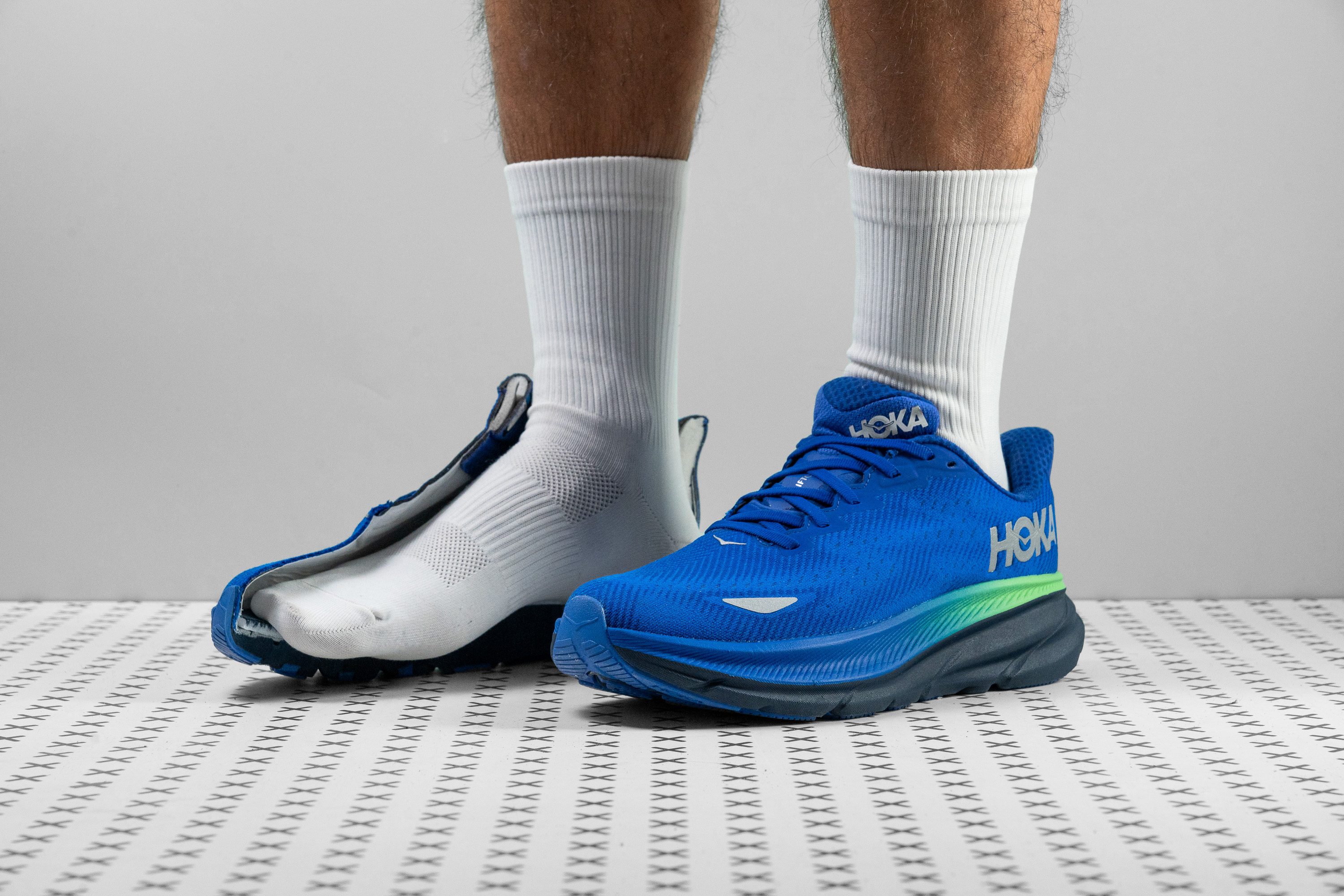



















































What makes it the best?
Hoka Clifton 9 GTX screams comfort in our strolls, providing the best lightweight experience among our lab-tested waterproof walking shoes. Its generous yet stable platform and dense upper spare us from discomfort and potential injury, while maintaining a surprisingly light build.
Our in-shoe experience with this Hoka is hard to match, as we felt like we could strut the streets endlessly with its abundant cushioning. Our calliper measures a tall 37.2/28.6 mm stack, offering much more impact protection and comfort compared to the 33.6/24.8 mm average. Despite this, it maintains an astonishingly light weight of 9.6 oz (271g).
Surprisingly, it doesn’t take a lot of effort to stabilise our landings. Clifton 9 GTX ensures our surefootedness by adding density to its cushion and width to its midsole. True enough, our durometer registers a balanced 23.9 HA. Meanwhile, the midsole measures 7.4/6.9 mm wider than average in the forefoot and heel.
Other than underfoot protection, the Gore-Tex membrane and dense jacquard mesh shield us from the top. It didn’t allow a single drop of water to enter, yet surprisingly felt quite breezy. Our lab reveals a rare 3/5 breathability score for this GTX shoe.
Because the toebox tapers more aggressively to the big toe, we believe this shoe isn’t ideal for wide or square-shaped feet.
Pros
- Exceptionally cushioned
- Comfortable and long-lasting upper
- Ideal for winter conditions
- Only $15 more expensive than the non-waterproof Clifton
- Still remarkably lightweight even with Gore-Tex
- Excellent for easy and moderate-paced runs
- Incredibly stable for neutral runners
- Ultra-durable Durabrasion outsole
Cons
- May be too narrow for many
- Heel-to-toe drop significantly differs from Hoka's claims
- Not enough energy return
- It needs more grip in wet surface
Waterproof walking shoes with the best durability
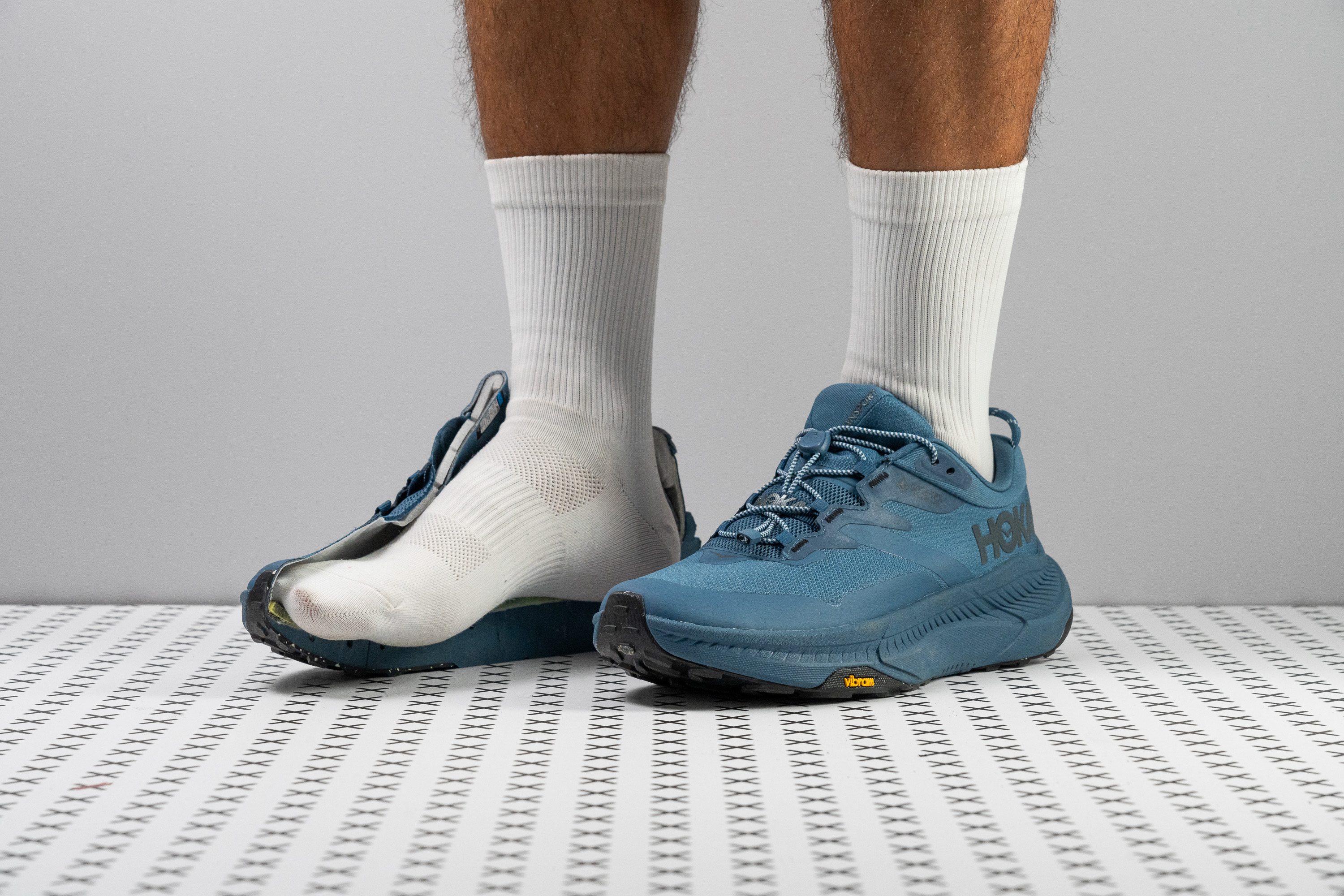






















































What makes it the best?
With its waterproof and bulletproof nature, we ultimately felt safe braving any road or weather condition in the Hoka Transport GTX. With its durable Cordura upper and rugged Vibram outsole, this shoe can withstand tough conditions while providing a stable and secure ride. According to our lab tests, it's the most durable waterproof walking shoe, offering unmatched protection and longevity.
The upper features a strong fabric called Cordura on top of the GTX membrane. This combination creates a highly protective shield, as evidenced by its 4/5 durability score in our Dremel test. Our feet felt warm and dry even as we encountered slush and snow. Our breathability test mirrors this with the lowest 1/5 score.
Complementing the solid upper is the well-known Vibram outsole. Our durometer shows its hardness is above-average 81.0 HC, while its thickness is 21.4% above average. Both results ensure the shoe will last many seasons and effectively deliver underfoot protection. Its grip is top-notch, with a 0.56 friction coefficient in our traction test. With a 21.7% stronger grip than average, we ventured into wet surfaces with no hesitation.
We felt planted to the ground during our strolls thanks to the shoe’s rigid build that prevents unwanted excessive movements. In our manual assessment, the midsole highly resists twisting, earning the highest 5/5 torsional rigidity score. Meanwhile, in our bend test, it emerged 22.8% stiffer than average.
However, all the toughness led to a heavier weight of 11.6 oz (330g), 19.1% above average. Those who prefer a more weightless feel should check alternatives.
Pros
- Top-class waterproofing
- Cushioned and supportive for all-day wear
- Smooth strides thanks to rockered shape
- Very stable platform
- Highly durable construction
- Excellent grip on dry and wet city streets
- Quick and easy lacing system (regular laces included in the box as well)
- Reflective elements all throughout the upper
- Sustainable materials in almost every shoe part
Cons
- A bit heavier than average
- Major stack and drop discrepancy with official specs
- Not for wide feet
Waterproof walking shoes with the best shock absorption





















































What makes it the best?
Of all the waterproof walking shoes we took to our walks and put through lab tests, the Nike Pegasus 41 GTX offered unmatched shock absorption. Built for the outdoors with its grip and weatherproof upper, we found the Peg thrives in wet conditions while keeping our feet spoiled with a plush and bouncy midsole.
The cushioning brings our feet home as it impressively blends energy return with a cloud-like sensation. Our calliper shows a generous 36.4 mm heel stack for impact protection, made of foam that reduces shock better than average with its 129 SA score. Plus, we found Air Zoom units in the heel and forefoot for enhanced comfort and bounce, allowing us to walk longer distances effortlessly.
Our feet remained dry even when liquid was poured over the upper, thanks to the Gore-Tex membrane. Under our microscope, we saw a tightly woven material, which made us expect its 1/5 breathability score in our smoke test. Truly, there's no need to fear a little rain, especially since the fully gusseted tongue completes the waterproofing solution.
To ensure our safety, the grippy Storm-Tread outsole offers control on slippery surfaces, with a lug design intentionally meant for wet conditions.
However, the toebox tapers aggressively to the front which may restrict those with broad feet. Those in need of more wiggle room should find more accommodating shoes.
Pros
- Waterproof Gore-Tex membrane
- Dual Air Zoom units
- Improved tongue padding
- Durable yet comfy upper
- Rugged toe bumper
- ReactX bouncy foam
- Keeps feet warm
- Reliable grip on wet surfaces
- Amazing for heel strikers
Cons
- Tapered toebox
- Heavy
- Outsole durability concerns
- Maybe a bit pricey
Waterproof walking shoes with the best stability



















































What makes it the best?
A superbly cushioned yet remarkably stable ride is what the Hoka Challenger 7 GTX delivered in our actual walks. With its grippy lugs and waterproof upper comes reliable protection for any terrain and weather, allowing us to enjoy the outdoors without any worries. After delving deeper inside our lab, this shoe reveals several sources of our surefootedness.
First, we discovered not only a plush cushion but a wide one too. Our calliper reveals a generous forefoot and heel of 116.4/100.9 mm for steadier landings than the average 111.8/89.6 mm. Because of the shoe’s gigantic stack, it’s tougher to twist and bend, which effectively mitigated excessive lateral movements and ankle rolls. Our lab confirms our assessment with a 5/5 torsional rigidity score and longitudinal rigidity that’s 18.2% above average.
Further improving our control is the grippy 3.8 mm lugs that display excellent adhesive power on wet pavements and off-the-beaten paths. We like how they don’t feel intrusive on hard concrete and asphalt.
Another feature we truly appreciated is the waterproof upper that kept the cold, moisture, and even debris away. We weren’t afraid to walk through puddles and streams with this pair.
However, those with wide or square-shaped feet should know the big toe area is 4.5 mm narrower than average. Those who prefer more wiggle room should check elsewhere.
Pros
- Fully waterproof and winter-ready
- Secure lockdown thanks to the gusseted tongue
- Amazing stability
- Provides a comfortable ride on roads and easy trails
- Ideal for long runs
- Generous CMEVA cushioning underfoot
- Surprisingly lightweight given its stack height
- Just $15 more than the regular version
Cons
- Lacks reflective elements
- Potentially too stiff for hiking for some users
- Higher heel-to-toe drop than anticipated
- Ultra-tapered toebox
Best affordable waterproof walking shoes
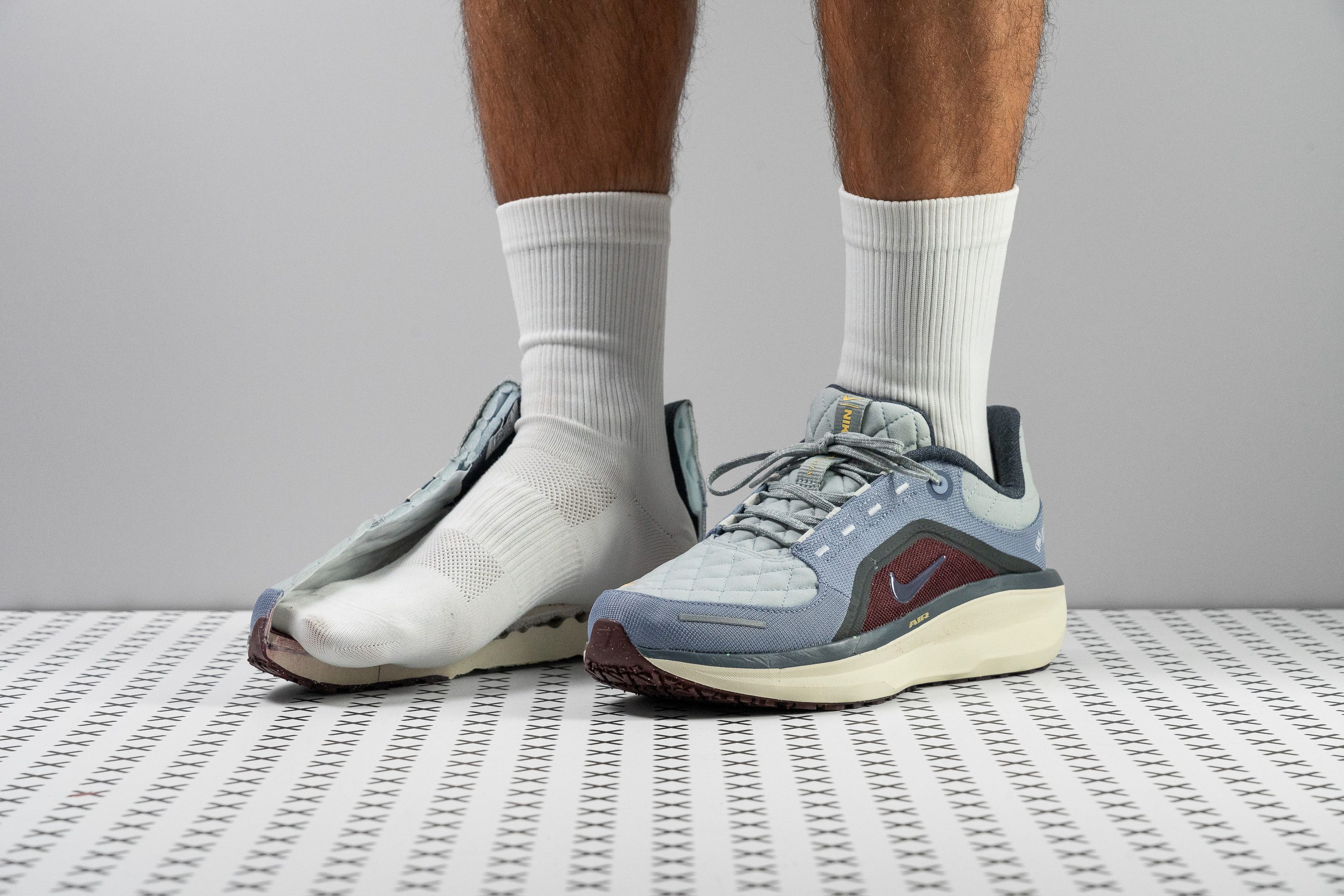






















































What makes it the best?
Nike’s Winflo 11 GTX leaves us with no excuses to skip walks in the rain or snow because it offers protection, grip, and comfort at an accessible £130 price, making it our best affordable waterproof walking shoe. For reference, the average Gore-Tex in our lab costs £150, making the Winflo 11 GTX such a steal for all that it offers.
Our feet felt cosy and safe throughout our outdoor tests in wet or sub-zero temperatures. Even if rain hits, our feet remain completely dry thanks to the Gore-Tex membrane and tightly knit upper. Our smoke test backs up our experience with a 1/5 breathability score, as we enjoy the warmth and cosiness the padding brings.
This shoe delivers generous cushioning underfoot for protection against repetitive impact, particularly in its 39.0 mm heel. The platform feels plush, clocking in at 15.4 HA, with a softness further enhanced by the full-length Air unit.
Beneath the midsole lies the Storm-Tread outsole. True to its name, it's ready for any storm serving a reliable grip on slippery roads. We even find that it performs best in wet conditions!
However, a plush and stacked platform means a less stable ride. Those in need of more guidance should find more supportive walking shoes.
Pros
- Plush midsole
- Massive heel stack
- Fantastic Gore-Tex upper
- Superb traction on wet roads
- A-tier upper durability
- Awesome value
- Full-length air unit
- Made for heel strikers
- Great for beginners
Cons
- Not very stable
- Midsole firmens significantly in cold temperatures
- Bad performance on dry roads
- High drop may not suit all footstrikes
When (not) to get waterproof walking shoes
Light drizzles and occasional puddles are probably not the reason why you are looking for a pair of waterproof walking shoes.
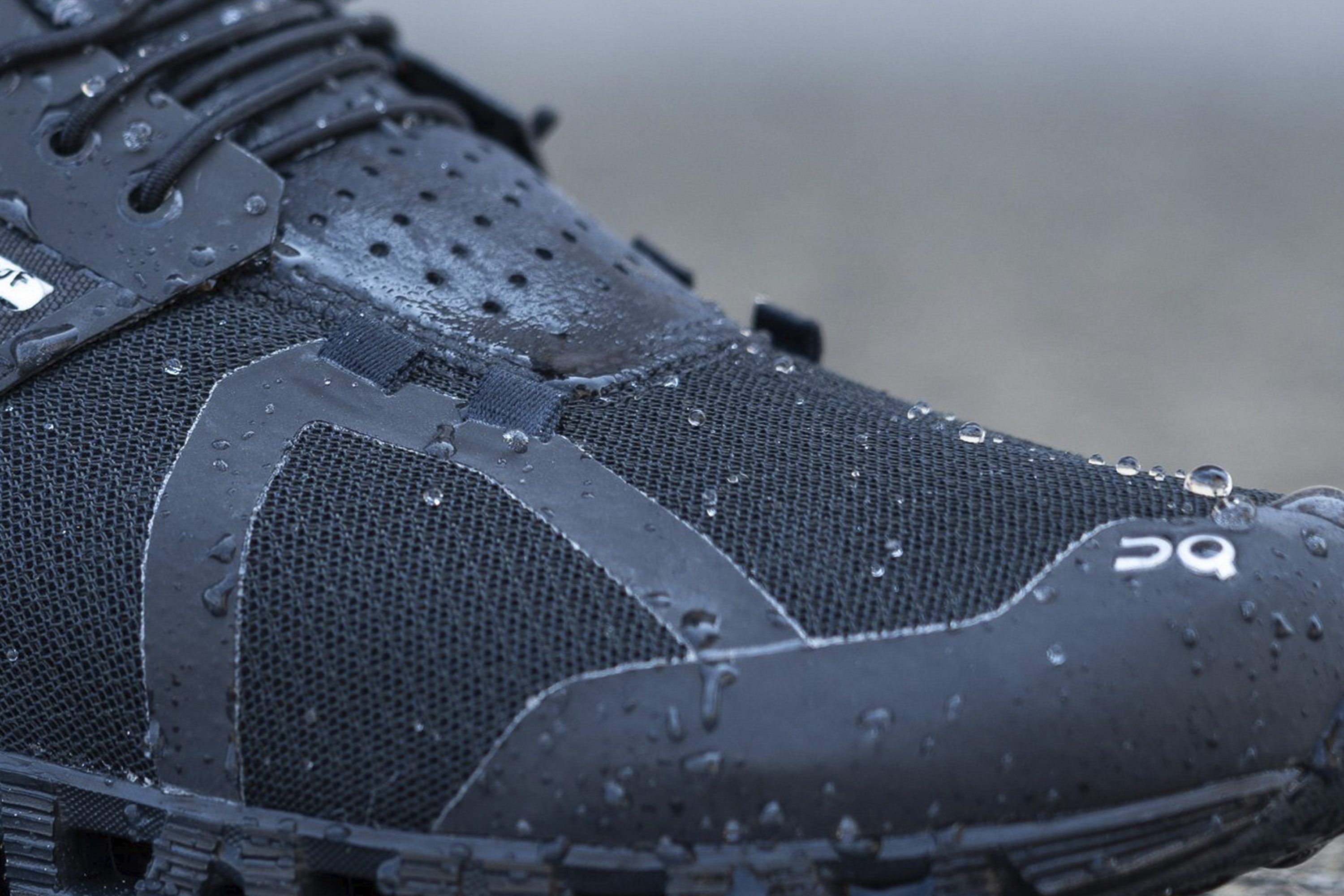
Because there is a considerable tradeoff in breathability and price, getting a waterproof shoe should be justified by the poor weather conditions. In other words, is the rain and snow bad enough for you to invest in waterproofing, or perhaps a water-repellent or water-resistant shoe can do the job?
|
Water-resistant |
Water-repellent |
Waterproof |
|
|
Best for |
light rain and dry snow |
light-to-moderate rain, average snow |
moderate-to-heavy rain, wet snow |
|
Water pressure resistance* |
0-5000 mm (no pressure) |
5000-10000 mm (light pressure) |
10000-20000 mm (high or very high pressure) |
*Measured by the hydrostatic head in millimetres. A 1’’ x 1’’ tube is put over a piece of fabric and is gradually filled with water. The number of millimetres of water that the tube can take before water begins to leak through the material is the hydrostatic head. The lower the number in mm, the less waterproof the fabric.
Water-resistant shoes usually have a tightly woven fabric upper that is naturally capable of resisting water upon contact. Leather and suede uppers also have some inherent water resistance. These shoes are fairly breathable.
Water-repellent shoes have their uppers treated with a durable water-repellent (DWR) finish or other hydrophobic chemicals. This impacts breathability but some ventilation is still present.
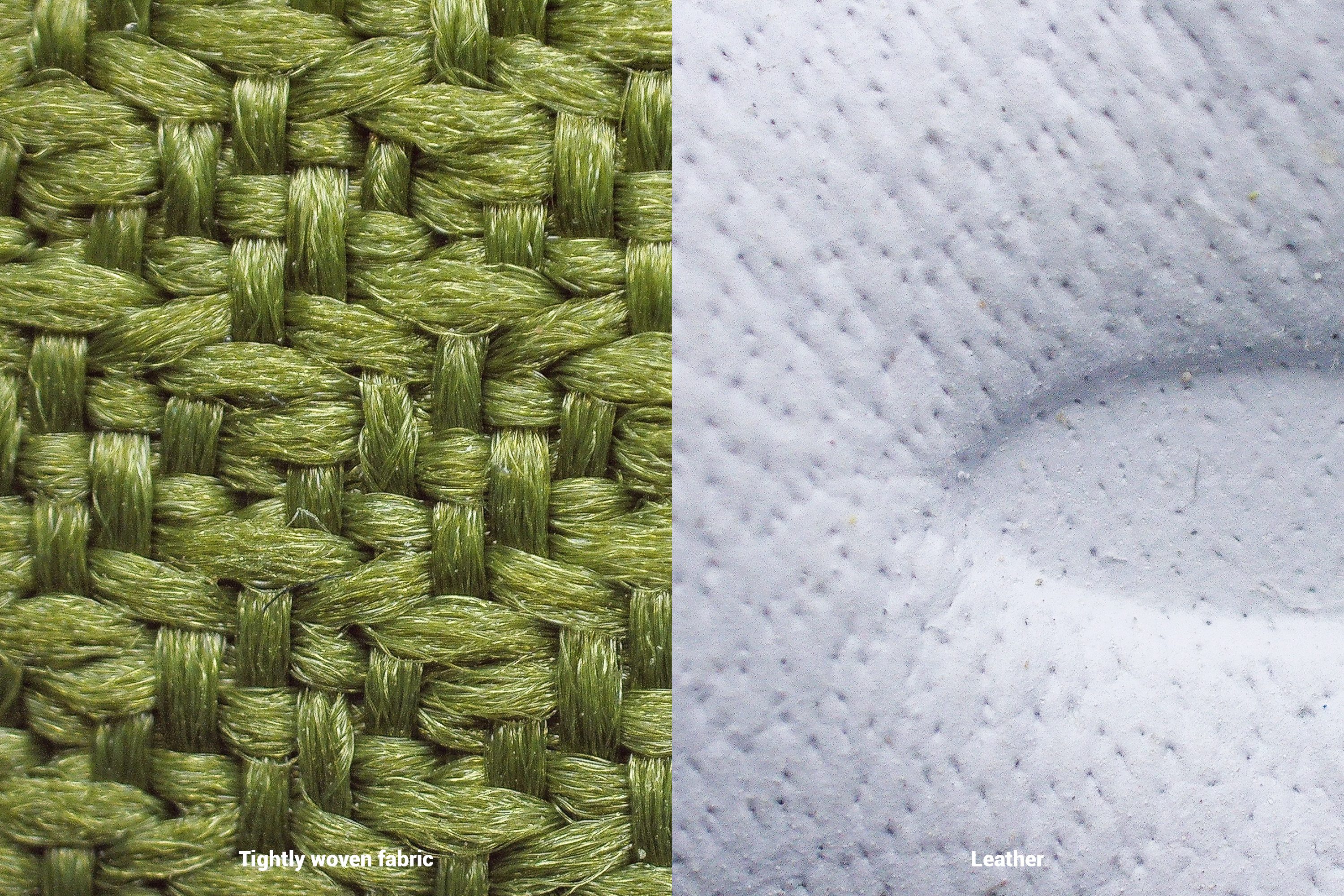
Waterproof shoes feature a Gore-Tex (GTX) membrane or other brand-specific waterproofing technology that can resist up to 20000 mm of water at high pressure (i.e. downpour or stepping in a puddle). Most often, it is additionally coated with a water-repellent (DWR) finish. The tongue of these shoes is fully attached to the quarters (fully gusseted) closing the gaps in the upper. All of this makes waterproof shoes very warm and leaves little to no airflow.
Considering all of the above, here are the reasons to buy waterproof walking shoes:
- You regularly walk in moderate-to-heavy rain, slush, wet grass, and soggy conditions.
- You need a warm pair of shoes for temperatures below 50°F (10°C).
On the flip side, here are some of the reasons NOT to buy waterproof walking shoes:
- You deal with moderate weather with very few heavy rains and storms. A water-resistant or water-repellent shoe might be a better alternative.
- You usually walk at temperatures above 50°F (10°C) and warm shoes make your feet sweat. It’s better to get a breathable shoe but regulate the warmth with good socks (wool or bamboo).
- You often step into puddles or snow/slush that are ankle-deep or even deeper. Once the water seeps inside a waterproof shoe, it will keep your feet soggy all the time. In that case, a mid-cut waterproof hiking boot might be more suitable.
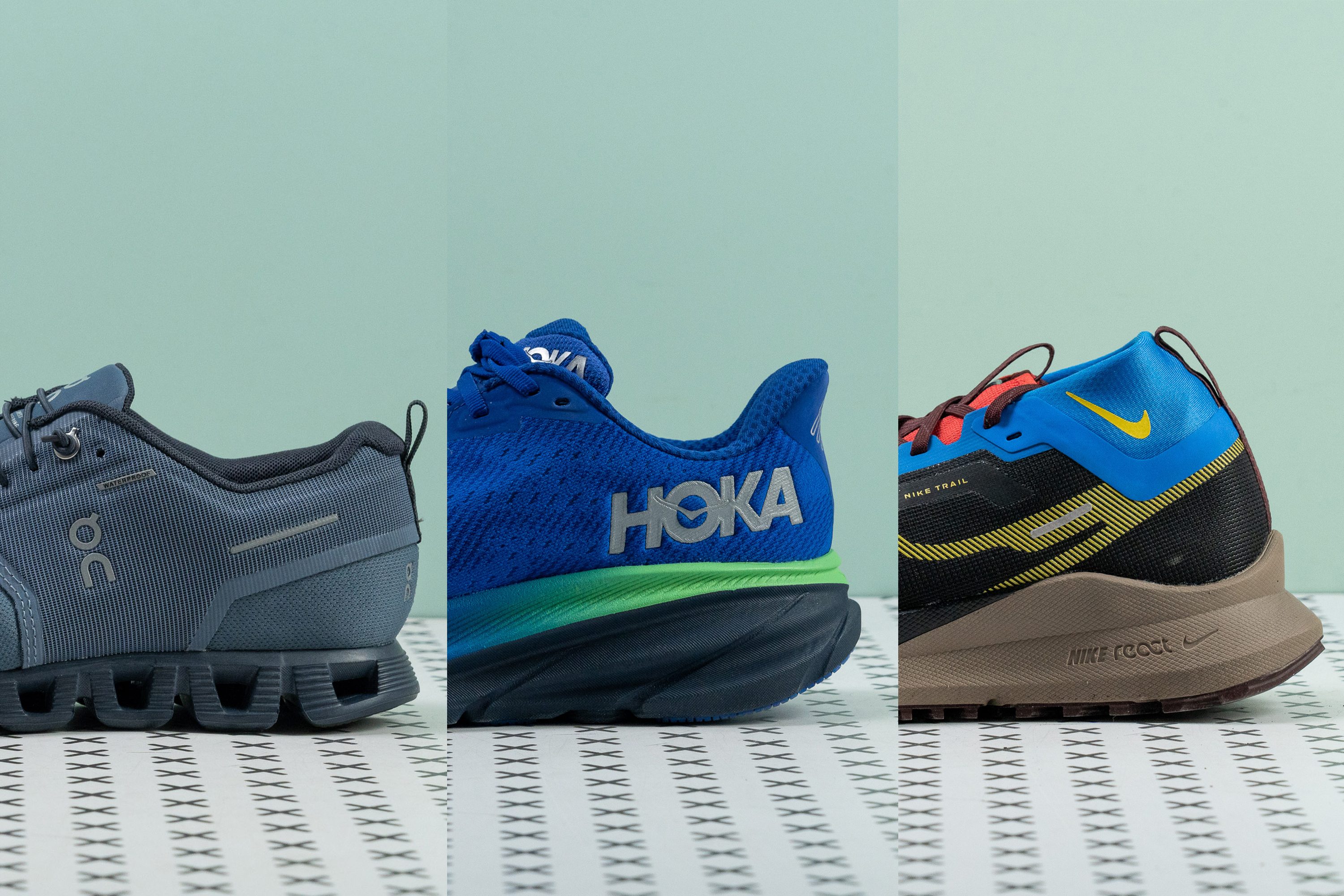
How to tell if a shoe is waterproof
First of all, look at the shoe’s name. Words like “Gore-Tex” (“GTX”) or “Waterproof” (“WP”) are usually the most common indication.
Even though some brands design their own waterproofing technologies, Gore-Tex remains the world’s leading membrane. Nike, Adidas, Hoka, and many other reputable footwear companies are choosing Gore-Tex to make waterproof versions of their most popular shoes. What’s more, this material is very extensively used in all sorts of outdoor gear and even in military apparel and medical devices.
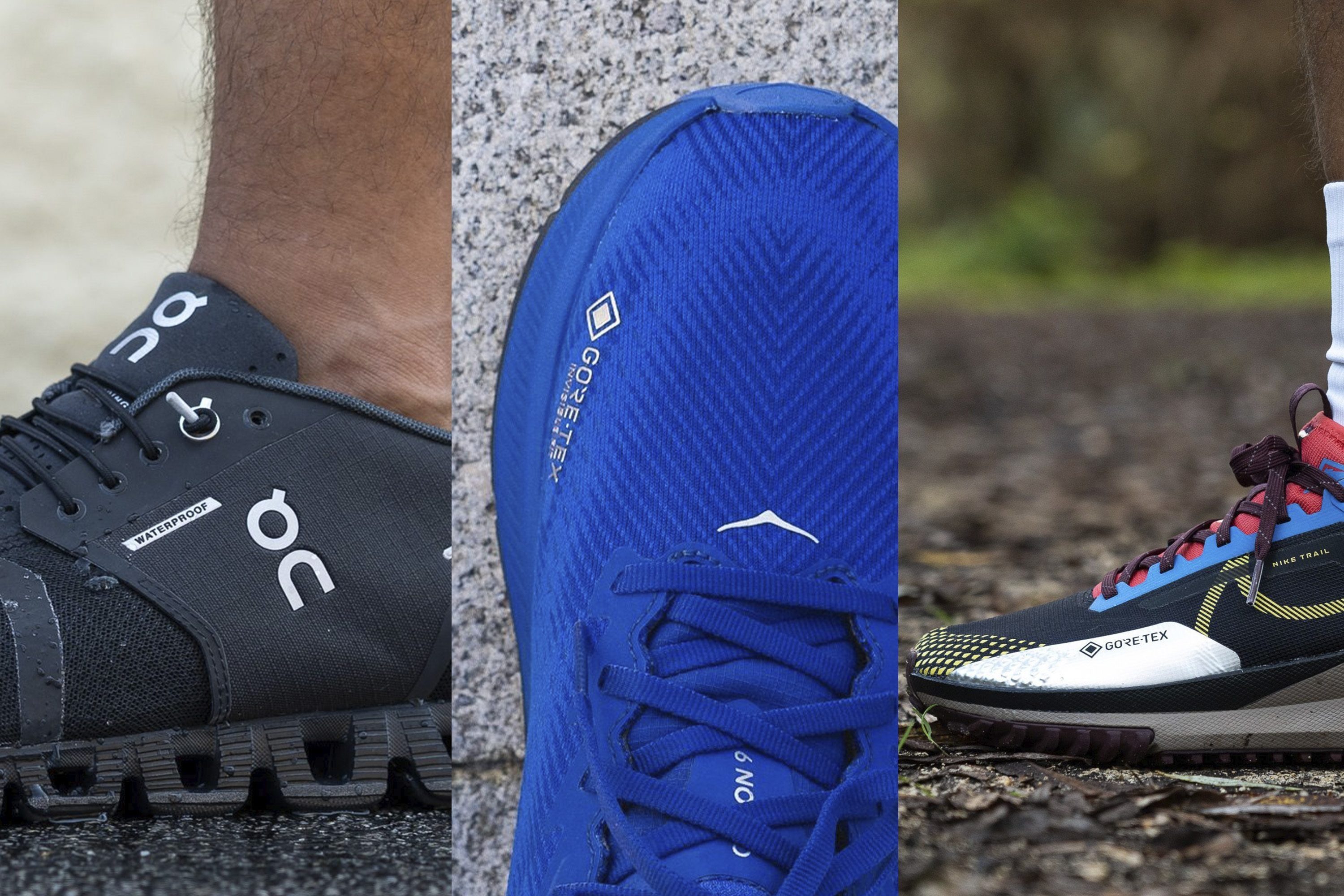
Taking a closer look at the upper of waterproof shoes, you will find a very close-knit fabric that has no ventilation pores or perforations.

And if you investigate the inner lining of these shoes, you will notice a thick shiny material that seals the shoe from the inside. That is the waterproof membrane and it is important to keep it intact so that the shoe doesn’t lose its protective features.

Last but not least, the tongue of a waterproof shoe is fully attached to the rest of the upper. This prevents water from seeping through the gaps.
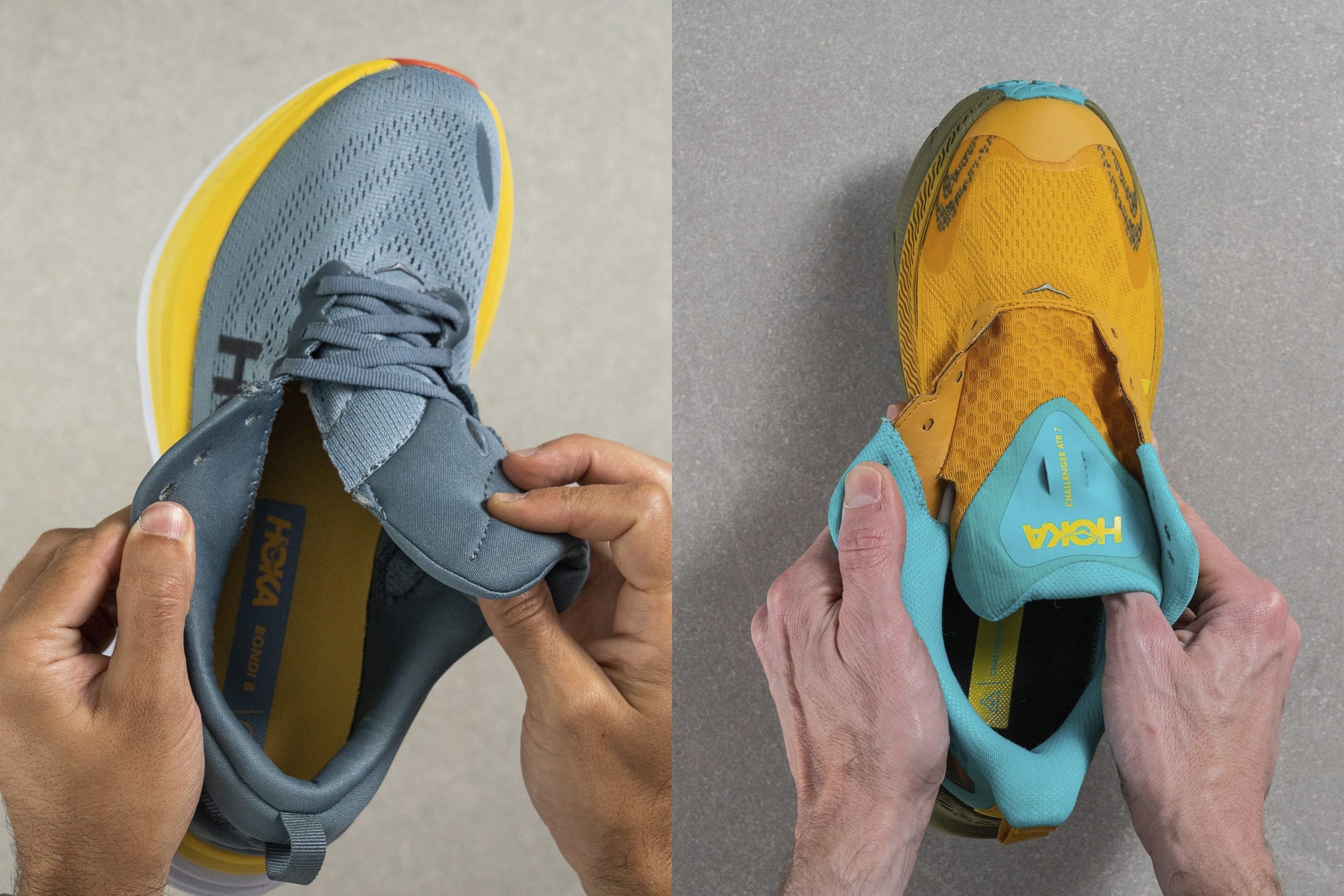
Don't overlook the grip
Good waterproof walking shoes will not only keep your feet dry in the upper but will also keep you surefooted on wet concrete and grass, mud, slush, and snow.
We highly recommend that you avoid shoes with flat soles and too much exposed foam as these are a true slipping hazard on wet surfaces.
Checking the outsole of a waterproof shoe, here is what you should look for:
- Sufficient rubber coverage (at least 50% of the sole) or even a full-length rubber outsole
- Textured tread pattern and channels (grooves and curves)
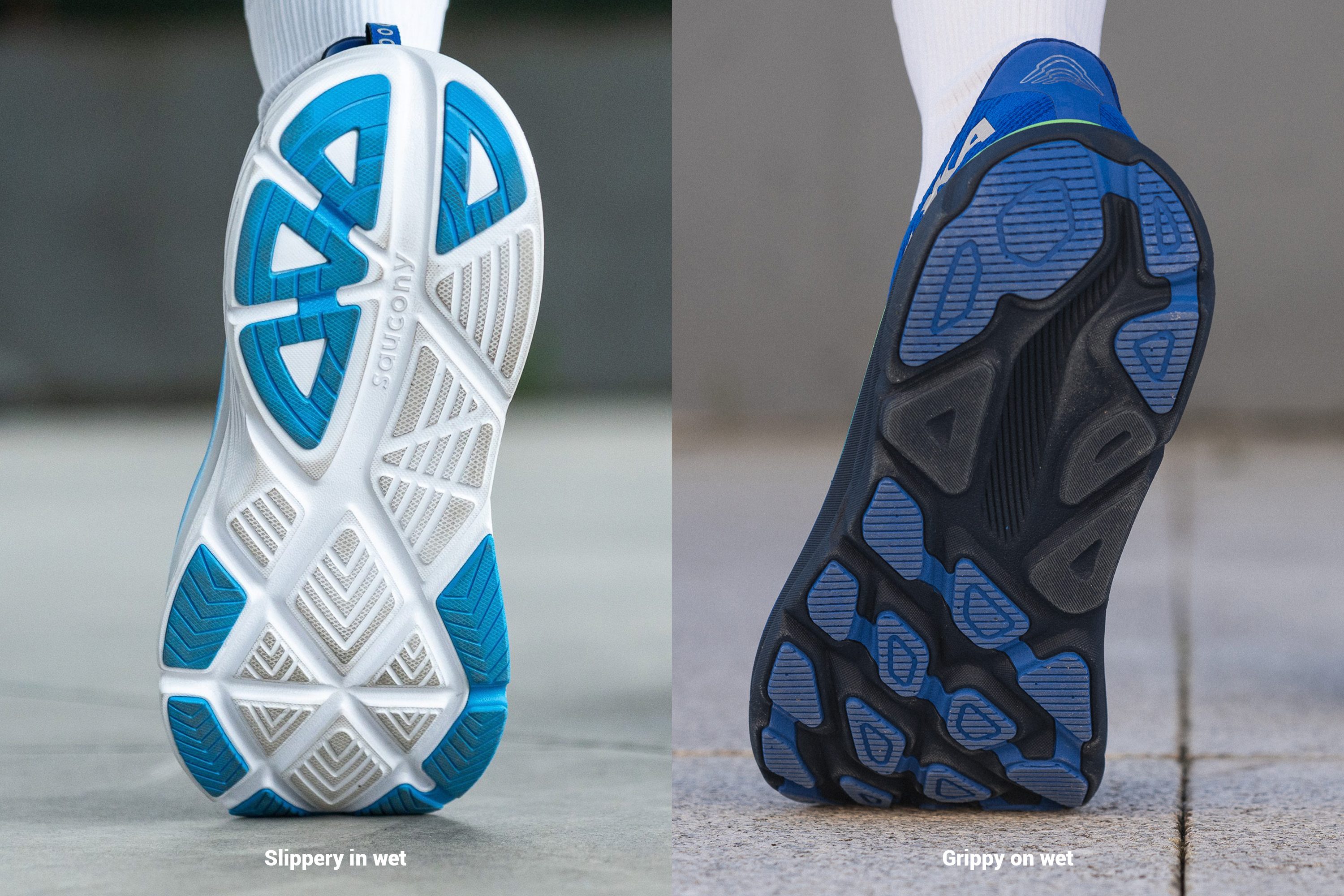
In trail shoes, deeper lugs are a must for biting into soft and wet terrain. Look for at least 3.5 mm of lug depth.
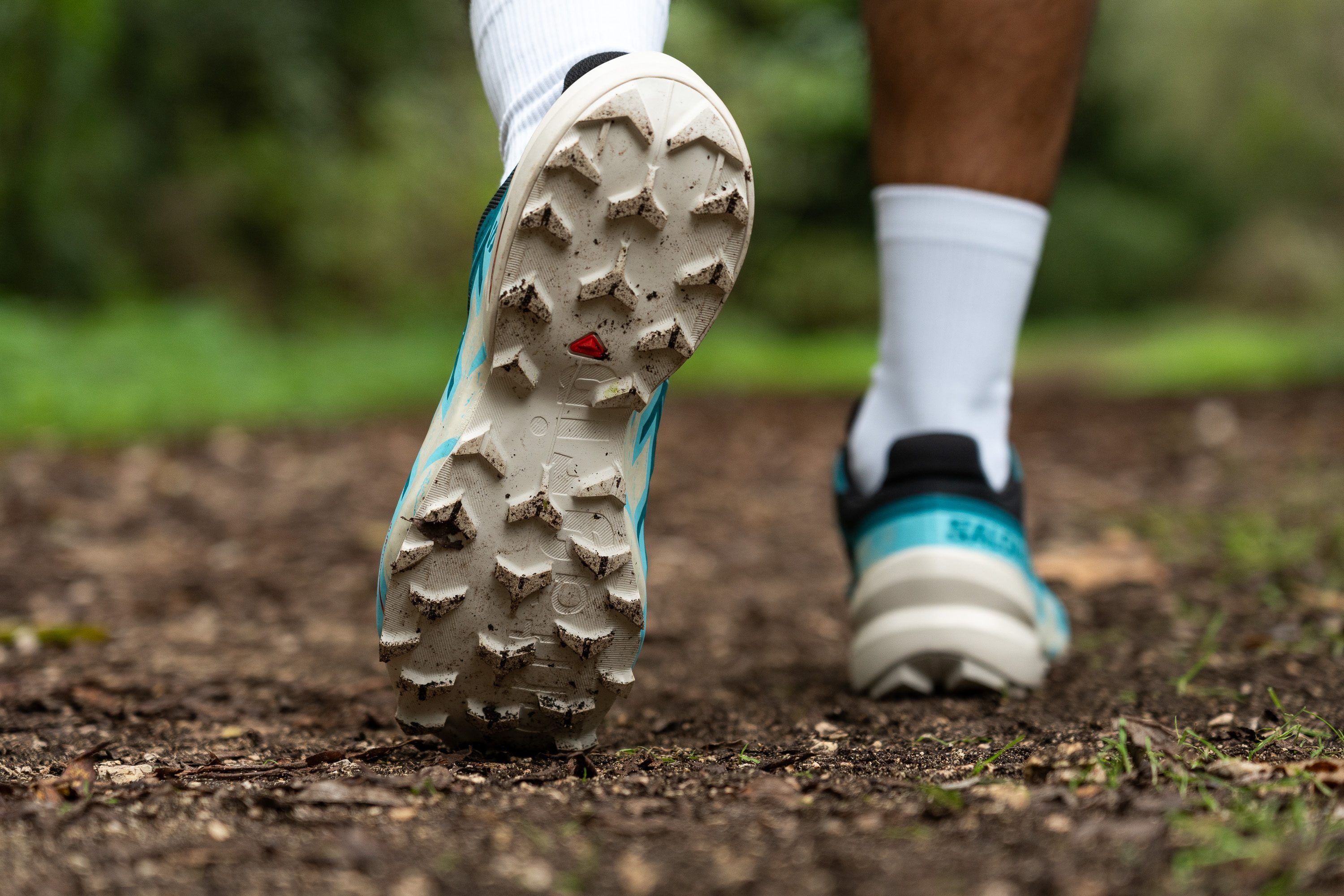
As long as the rubber remains unscathed, the grip is there. So it is important to get a waterproof walking shoe with a durable rubber outsole. We check the abrasion resistance of each rubber outsole in our lab to help you choose wisely.
We drill the outsole using a Dremel with sandpaper and then measure the depth of the dent it left on the rubber. The smaller the reading the more hard-wearing it is.

